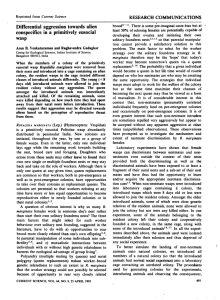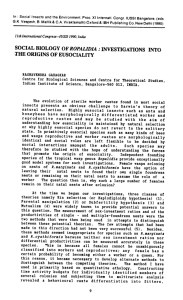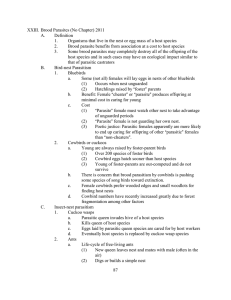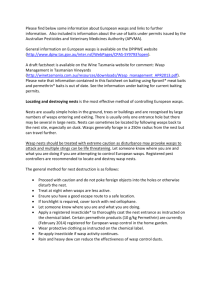RESEARCH COMMUNICATIONS Differential aggression towards alien
advertisement
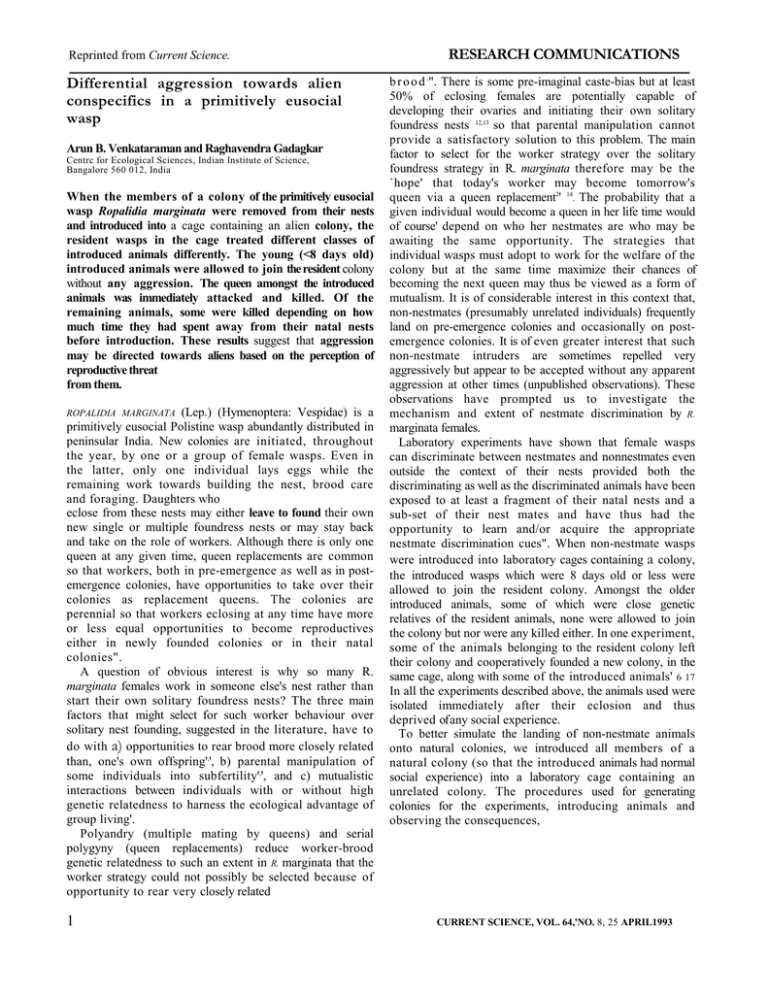
Reprinted from Current Science. Differential aggression towards alien conspecifics in a primitively eusocial wasp Arun B. Venkataraman and Raghavendra Gadagkar Centrc for Ecological Sciences, Indian Institute of Science, Bangalore 560 012, India When the members of a colony of the primitively eusocial wasp Ropalidia marginata were removed from their nests and introduced into a cage containing an alien colony, the resident wasps in the cage treated different classes of introduced animals differently. The young (<8 days old) introduced animals were allowed to join the resident colony without any aggression. The queen amongst the introduced animals was immediately attacked and killed. Of the remaining animals, some were killed depending on how much time they had spent away from their natal nests before introduction. These results suggest that aggression may be directed towards aliens based on the perception of reproductive threat from them. ROPALIDIA MARGINATA (Lep.) (Hymenoptera: Vespidae) is a primitively eusocial Polistine wasp abundantly distributed in peninsular India. New colonies are initiated, throughout the year, by one or a group of female wasps. Even in the latter, only one individual lays eggs while the remaining work towards building the nest, brood care and foraging. Daughters who eclose from these nests may either leave to found their own new single or multiple foundress nests or may stay back and take on the role of workers. Although there is only one queen at any given time, queen replacements are common so that workers, both in pre-emergence as well as in postemergence colonies, have opportunities to take over their colonies as replacement queens. The colonies are perennial so that workers eclosing at any time have more or less equal opportunities to become reproductives either in newly founded colonies or in their natal colonies". A question of obvious interest is why so many R. marginata females work in someone else's nest rather than start their own solitary foundress nests? The three main factors that might select for such worker behaviour over solitary nest founding, suggested in the literature, have to do with a) opportunities to rear brood more closely related than, one's own offspring',', b) parental manipulation of some individuals into subfertility',', and c) mutualistic interactions between individuals with or without high genetic relatedness to harness the ecological advantage of group living'. Polyandry (multiple mating by queens) and serial polygyny (queen replacements) reduce worker-brood genetic relatedness to such an extent in R. marginata that the worker strategy could not possibly be selected because of opportunity to rear very closely related 1 RESEARCH COMMUNICATIONS b r o o d -". There is some pre-imaginal caste-bias but at least 50% of eclosing females are potentially capable of developing their ovaries and initiating their own solitary foundress nests 12,13 so that parental manipulation cannot provide a satisfactory solution to this problem. The main factor to select for the worker strategy over the solitary foundress strategy in R. marginata therefore may be the `hope' that today's worker may become tomorrow's queen via a queen replacement2' 14. The probability that a given individual would become a queen in her life time would of course' depend on who her nestmates are who may be awaiting the same opportunity. The strategies that individual wasps must adopt to work for the welfare of the colony but at the same time maximize their chances of becoming the next queen may thus be viewed as a form of mutualism. It is of considerable interest in this context that, non-nestmates (presumably unrelated individuals) frequently land on pre-emergence colonies and occasionally on postemergence colonies. It is of even greater interest that such non-nestmate intruders are sometimes repelled very aggressively but appear to be accepted without any apparent aggression at other times (unpublished observations). These observations have prompted us to investigate the mechanism and extent of nestmate discrimination by R. marginata females. Laboratory experiments have shown that female wasps can discriminate between nestmates and nonnestmates even outside the context of their nests provided both the discriminating as well as the discriminated animals have been exposed to at least a fragment of their natal nests and a sub-set of their nest mates and have thus had the opportunity to learn and/or acquire the appropriate nestmate discrimination cues". When non-nestmate wasps were introduced into laboratory cages containing a colony, the introduced wasps which were 8 days old or less were allowed to join the resident colony. Amongst the older introduced animals, some of which were close genetic relatives of the resident animals, none were allowed to join the colony but nor were any killed either. In one experiment, some of the animals belonging to the resident colony left their colony and cooperatively founded a new colony, in the same cage, along with some of the introduced animals' 6' 17 In all the experiments described above, the animals used were isolated immediately after their eclosion and thus deprived of any social experience. To better simulate the landing of non-nestmate animals onto natural colonies, we introduced all members of a natural colony (so that the introduced animals had normal social experience) into a laboratory cage containing an unrelated colony. The procedures used for generating colonies for the experiments, introducing animals and observing the consequences, CURRENT SCIENCE, VOL. 64,'NO. 8, 25 APRIL1993 RESEARCH COMMUNICATIONS have been described in detail elsewhere 16. ". The most striking result of this study was that the queen amongst the introduced animals was selectively attacked, dismembered and killed within a few hours of introduction. Almost all the aggression by the resident animals was directed to the alien queen as long as she was alive. Although we repeated this experiment thrice, it is a pity that this singular behaviour could not be reconfirmed. In one of the other experiments the queen died a day before the introduction and in the other, no clear queen could be discerned among the introduced animals. Of the 34, 19 and 28 animals introduced in the three experiments respectively, 2, 6 and 0 respectively were accepted, 2, 4 and 7 respectively were killed while the remaining were allowed to live in the cage without either being killed or being accepted onto the resident animals' colony. As in previous experiments 16, 17, all the accepted animals were less than 8 days of age. But what was the criterion used for selectively killing certain animals? We asked if the behavioural profile of an introduced animal in its natal nest before the experiment somehow affected its probability of being killed. The behavioural profiles of all animals in their natal colonies were determined as described elsewherel8, before introduction. As in previous studies 18,19, most of the time of the wasps was spent in five behaviours namely, sit and groom, sit with raised antennae, walking, in cells and absent from nest. Using the proportion of time spent in each of the five behaviours in their natal nests as independent variables and being killed or not being killed after introduction as the binary dependent variable, we performed a logistic regression analysis, as described elsewhere 12,13 to ask if the time budget of an animal in its natal colony influenced its probability of being killed in the cage it was introduced into. The only statistically significant logistic regression coefficient was ' negative and was the one associated with the proportion of time spent in being absent from nest (Table 1). What this means of course is that introduced animals that had spent a high proportion of their time away from their natal nests had a low probability of being killed while those that spent a high proportion of their time on their natal nests had a high probability of being killed, when introduced into a cage containing an alien colony. A similar result was obtained when we divided the introduced animals into three classes depending on the proportion of their time they spent away from their natal nests and computed the proportion of animals in each class that were killed (Figure 1). Nearly 70% of the animals that had spent less than 25% of their time absent from their natal nests were killed while less than 20% of the animals that had spent more than 25% of their time absent from their natal nests were killed. The ultimate (evolutionary) advantage or adaptive value of accepting young animals, being singularly 07 06 05 Y C 0 0.4 6 03 02 0.1 00-025 0.25-0.5 Proportion of time absent from nest 05-1.0 Figure 1. Proportion of animals killed in each class. The classes are based on the proportion of their time that the wasps spent in being absent from their natal nests prior to introduction. The proportion of animals killed is not independent of the class to which they belong (X2=9.05, P<0.05). aggressive towards an alien egg layer and killing aliens depending on the proportion of time they had spent absent from their natal nests is probably related to extent of reproductive competition that resident Table 1. Logistic regression analysis linking the probability that an introduced wasp is killed with the proportion of time it had spent being absent from its natal nest prior to introduction Independent variables tested, being the proportions of time Logistic spent by wasps in different Standard regression activities, in their natal error coefficients nests, prior to introduction z Absent from nest Sitting and grooming Walking Sitting with raised antennae In cells -7.04 2.62 15.46 1.40 3.91 3.07 2.24 8.66 5.11 11.40 -229* 1.17 1.92 0.28 0.34 *P < 0.05 2 CURRENT SCIENCE, VOL. 64,'NO. 8, 25 APRIL1993 RESEARCH COMMUNICATIONS animals expect to face from different classes of 'introduced aliens. Young animals (<8 days old) are known to have poorly developed ovaries (unpublished results) and may still be amenable to being channeled into non-reproductive roles. The queen among the aliens clearly presents the greatest reproductive threat. Among the remaining animals, foragers (who always happen to be animals that have spent more time absent from their natal nests) perhaps present less reproductive threat because foragers tend to have relatively poorly developed ovaries". Besides, animals with a foraging experience should be preferred partners for new cooperative colony founding ventures. The proximate cues that the resident wasps use in distinguishing potential foragers from non-foragers and egg layers from non-egg layers among aliens may well be directly linked to the extent of their ovarian development. On the other hand, since nestmate discrimination in R. marginata is dependent on acquiring recognition cues from the nest and/or nestmatesls, egg layers and non-foragers are likely to have the strongest cues associated with their natal nests and young animals are likely to have the weakest of such cues. Directing aggression in proportion to how different (non-nestmate like) an animal smells might therefore yield the same results. Many studies have been conducted to investigate the acceptance or otherwise of alien conspecifics into social insect colonies2o-3o, but to. the best of our knowledge, none has focused on the possible influence of prior social experience of the aliens. The results presented here and their possible interpretation that we have indicated makes R. marginata a fascinating system to investigate the role of mutualism in the evolution of insect sociality. 1. Gadagkar, R., Gadgil, M., Joshi, N. V. and Mahabal, A. S., Proc. Indian Acad. Sci. (Anim. Sci.), 1982, 91, 539-552. 2. Gadagkar, R., in The Social Biology of Wasps, (eds. Ross, K. G. and Matthews, R. W.), Cornell University Press, Ithaca, New York, 1991, pp. 149-190. 3 3. Hamilton, W. D., J. Theor. Blot., 1964a, 7,1--16. 4. Hamilton, W. D., J. Theor. Biol., 1964b, 7,17-52. 5. Alexander, R. D., Annu. Rev. Ecol. Syst., 1974, 5, 325-383. 6. West-Eberhard, M. J., Quart. Rev. Biol., 1975, 50, 1-33. 7. Lin, N. and Michener, C. D., Quart. Rev. Biol., 1972, 47,131-159. 8. Muralidharan, K., Shaila, M. S. and Gadagkar, R., J. Genet., 1986, 65, 153-158. 9. Gadagkar, R., in Social Insects: An Indian Perspective, (eds. Veeresh, G. K., Kumar, A. R. V. and Shivashankar, T.), LUSSIIndian Chapter, Bangalore, Oxford & IBH Publishing, ' New Delhi, 1990, p. 129--152. 10. Gadagkar, R., Chandrashekara, K., Chandran, S. and Bhagavan, S., Naturwissenschaften, 1991, 78, 523--526. 11. Gadagkar, R., Chandrashekara, K., Chandran, S, and Bhagavan. S., in Queen Number and Sociality in Insects, (ed. Keller, L.), Oxford University Press, 1983, p. 187-214. 12. Gadagkar, R., Vinutha, C., Shanubhogue, A. and Gore, A. P., Proc. R. Soc. London, 1988, B233, 175-189. 13. Gadagkar, R., Bhagavan, S., Malpe, R. and Vinutha, C., Proc. Indian Acad. Sri. (Anim. Sci.), 1990, 99, 141-150. 14. Gadagkar, R., J. Genet., 1990, 69, 113 125. 15. Venkataraman, A. B., Swarnalatha, V. B., Nair, P. and Gadagkar, R., Behav. Ecol. Sociobiol., 1988, 23, 271-279. 16. Venkataraman, A. B. and Gadagkar, R., Insectes Soc., 1992, 39, 285-299. 17. Venkataraman, A. B. and Gadagkar, R., in preparation. 18. Gadagkar, R. and Joshi, N. V., Anim. Behav., 1983, 31, 26-31. 19. Chandrashekara, K. and Gadagkar, R., Ethology, 1991, 87, 269 283. 20. Greenberg, L., Science, 1979, 206, 1095-1097. 21. Mintzer, A., Science, 1982, 222, 1027-1029. 22. Carlin, N. and Holldobler, B., Science, 1983, 222, 1027-1029. 23. Mintzer, A. and Vinson, S. B., Behav. Ecol. Sociobiol., 1985, 17, 75-78. 24. Gamboa, G. J., Reeve, H. K. and Pfennig, D. W., Annu. Rev. Entomol., 1986, 31, 431-454. 25. Stuart, R. J., Anim. Behav., 1987a, 35, 1062-1069. 26. Stuart, R. J., Behav. Ecol. Sociobiol., 1987b, 21, 229-235. 27. Stuart, R. J., Proc. Natl. Acad. Sci. USA, 1988, 85, 4572-4575. 28. Morel, L. and Blum, M. S., Anim. Behav., 1988,36,718-725. 29. Crosland, M. W. J., Anim. Behav.. 1989, 37, 912-919. 30. Crosland, M. W. J., Anim. Behar.. 1990, 39, 413-425. ACKNOWLEDGEMENT. This work was supported in part by a grant from the Department of Science and Technology, Government of India. Received 10 February 1993; accepted 25 February 1993 CURRENT SCIENCE, VOL. 64,'NO. 8, 25 APRIL1993
